Have you ever heard of such a term as shemagh in 2023? Maybe you know what it is? Most people do not understand what we are talking about now since this word is rather rarely met in everyday speech. So, in this article, you will learn what a shemagh is, what types there are and how to tie a shemagh for dust, wind, and sun protection. Boost the knowledge of survival skills and tactical clothing items by reading the article.
Definition Of Keffiyeh
The shemagh (or keffiyeh) is a commonly worn item of clothing (tactical scarf) in Middle Eastern countries. Also, it can be found in many survival gear lists for its protective features.
The primary purpose of wearing a keffiyeh is protection from natural phenomena and disasters:
- Sun protection
- Dust protection
- Wind protection
- As survival items (water filter, pillow, bag, towel)
In general, a few decades ago, the shemagh was not so common in Western countries since such an item of clothing is exclusively a symbol of the Middle East. In these countries, people wear a scarf to protect themselves from overheating and sandstorms.
Today, many American and British soldiers and also citizens use the keffiyeh for various needs. For instance, it helps the military forces to survive in dangerous situations. As a result, the combat capability of the army has a high level. Simplicity and versatility are the features that make the loose neck scarf a practical addition to many survival kits.
If you want to go to the desert, be sure to take a shemagh with you to protect your face, mouth, nose, head, and eyes. By the way, some people wear the shemagh as an accessory, thereby emphasizing their style. Others, in pandemic times, use it as a face mask. Thus, keffiyeh has a wide range of uses, which increases its popularity in the world.
People use cotton fabrics for the scarf’s production that are durable, wear-resistant, and elastic. Thanks to this material, the shemagh does not deteriorate under the influence of light, and when water gets into it, it dries quickly. The standard size of such a shemagh is small, although you may find larger sizes in shops. The history of the origin of keffiyeh goes back to the past when the Prophet Muhammad lived. In modern Arab countries, you may find an abundance of shades, shapes, and styles of such scarves, varying from region to region. The Middle East is always surprised with its traditions and culture, and shemagh is no exception. This is why preppers often put a shemagh in their tactical backpacks, and survivalists have it in their survival sacks.
Material Composition: covering the head, shoulders, and face
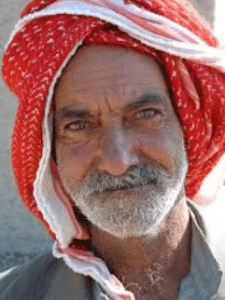
Why is such a shemagh worth buying? There are several reasons why shemagh is so popular, both among soldiers and among the population. Read carefully each point below, describing the rules of buying a shemagh.
1) Weight of the loose neck scarf
When choosing a neck scarf, its weight plays an essential role. Before buying such a product, think about what needs you will use it for. Do you want to use it for a head wrap or maybe to protect your mouth and nose? Or for self-expression as a stylish accessory? In general, the size and material of the scarf depend on the purpose of use. Indeed, if you want to defend yourself from the cold or rain, choose a dense shemagh. If you are in the desert, where the sun is hot, use a lighter product. And it will not add up significantly to your bug-out bag’s weight either.
2) Durability and Wear Resistance
Although such scarves should consist of durable material, there are often cases of low-quality production. For this reason, choose keffiyeh based on the properties of the material. The product should serve for a long time and have high wear resistance. Do not skimp on clothes if you need a shemagh to survive. It is better to pay once for a quality product than pay several times for the impractical ones.
3) Shades and Sizes
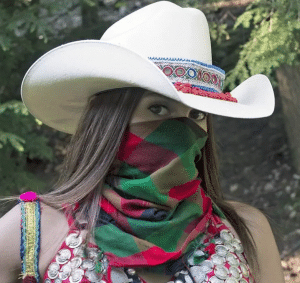
Such products are usually a 42-inch square. However, you may find a product of large sizes. This size of a shemagh is ideal for hiking and long-distance travel. Besides, a large head covering saves you from sunstroke or a downpour.
Now let’s look at ways to use a shemagh to survive in dangerous natural conditions.
Ways To Use Keffiyeh For Survival

1) Sun protection
Are you going on a trip where the sun shines and the sultry heat? You will need these products to protect your head from heatstroke. Wrap your head so that the sun’s rays do not fall on your skin. Thanks to this fabric, you will secure yourself from feeling unwell. By the way, you may also wrap the product around your face to protect your nose and mouth. To do this, take one corner of the fabric, and connect it with the other, making a triangle. Wrap the top part of your shemagh around your face and tie a knot at the back.
2) Dust, sand, and wind protection
Shemagh is great for protecting against dust and sand. As a rule, if you get into a strong sandstorm, you risk damaging your chin or nose with grains of sand. Therefore, in such conditions, use this product for protection. Wrap it around your nose and mouth, chin, and, if possible, chest. Don’t forget to pull it over your eyes to get a better view of the area.
3) Water filtration
Just imagine you are in the wild, and you need to find water suitable for drinking. However, you do not have a water filter that helps filter out water from bacteria and microbes. Most likely, you would have to drink untreated water because thirst is always unquenchable.
Now imagine that you have a shemagh. Thanks to it, you may half clean the water from large chunks and dirt. So you will at least protect your body from dirty particles and infectious diseases.
4) Pillow and blanket
During a hike and a long trip, bedding is always a necessary thing for a comfortable sleep. So, if you take such a soft fabric product, you will ensure a restful sleep. You may use the shemagh as a folding pillow. On the other hand, if you have brought T-shirts or shorts, use the product to wrap your clothes.
Moreover, thanks to the dense material, the shemagh is ideal as a blanket. It may warm you up in the cold period, and you will feel comfortable. You need to spread the shemagh into a full square and cover your body with it.
5) Equipment bag
If you don’t have a backpack or bag on hand, use a shemagh. Undoubtedly, it will not hold too heavy things, but for carrying equipment and small items – it is the very thing! Spread the keffiyeh evenly, place the necessary items in the center, take one corner of the lower half and fold the keffiyeh. Also, in a simplified version, you may tie the ends of the product tightly.
Use the product:
- As a towel for cooking
- As a blindfold
- As a signaling device
- As a silencer
- During a fire and an earthquake
6) First-aid item
In the forest, due to various dangers, people often get serious injuries up to open fractures. Undoubtedly, in such a situation, you immediately need to call an ambulance so that the medical workers have time to help you in time. You may also have a medical kit with you. But the forest is “outside the network’s coverage area,” and that’s why in case of injuries, you have to act yourself.
You may use keffiyeh as a tourniquet. Place the injured limb on a straight stick and tie the tourniquet between the wound and the chest. If you get a fracture, tie, for instance, a tree branch to a broken hand or leg. Stay calm and try to get to the hospital as soon as possible. An important point: in no case do not leave the bleeding and fracture without attention. Otherwise, you may die from blood loss.
7) Bandage for wounds
In case of getting skin cuts and wounds, you may use keffiyeh as a medical bandage. Do not forget that non-sterile product in direct contact with the blood cause blood poisoning and infectious inflammation. Therefore, it is better to use a shemagh for covering up and tying dressing.
8) Long rope
In any survival situation, a rope will not be an unnecessary item in the backpack. After cutting off the desired piece of fabric, you may hang things or tie them.
9) Towel
Finally, another option for using the product is a towel. A shemagh is superb as a cooling towel in hot weather and heat stroke. If you want to wash up, you may also use this product. By the way, shemagh as a rag is suitable for wiping sweat from the forehead, nose, neck, chin, and mouth.
10) Camouflage
In the forest, you need always remain invisible to reduce the likelihood of crossing with wild animals. If your shemagh has the same color as the area, most likely, no one will notice you. It is a great camouflage option in dangerous areas. Pull the shemagh over your forehead so that your eyes are barely visible, cover your nose and mouth, and tie the overhand knots tightly.
11) Head Wrap
According to the traditions of Middle Eastern countries and the whole Arab world, people usually fold the keffiyeh in a triangle – one side is on the other. Next, they put it on the head, tying a single knot tightly. But many people like to use it as a scarf and tie it around their neck. However, this is not a traditional way of wearing. To protect your head from the heat, you may pull the keffiyeh over your forehead and eyes.
It is not an exhaustive list of use cases for this product. The most important thing is to tie a shemagh tightly so that it does not break. Shemagh will come in handy under any circumstances!
Use Of This Product In Winter And Summer
The main question: does keffiyeh effectively protect against the cold in winter and from the sultry heat in summer? The answer is unequivocal – yes! Such high-quality fabric products retain heat in cold weather so that your face will not freeze. In summer, thanks to the dense material, keffiyeh covers the head from the sun. Thus, the shemagh is worth buying because it is a superb option for protection!
How To Tie a Shemagh: Several Ways
If you bought keffiyeh for the first time and do not know how to tie it, use the tips. In general, the options for binding the shemagh around the head or face are similar. Therefore, you will not have any difficulties when tying it.
For more information, view a video that shows steps of tying the shemagh around the neck and head.
1) Tying the keffiyeh: triangle

- Firstly, fold the shemagh in half, making a triangle
- Cover your forehead with the folded edge
- Two corners of the fabric should be equidistant from the middle of your forehead.
- Place the right side under your chin, taking the folded edge to the left side.
- Do it over your left shoulder
- Hold the right side with your left hand
- Cover your face with the left side of the shemagh, pull it to the right side
- Be sure to cover your mouth and nose
- Tie two corners behind your head
- If you only need to hide your head, pull the lower half down
- Adjust and tie the keffiyeh so that it does not press
It is a universal wrapping style of a shemagh around the face and head. There are also several other ways to provide increased protection for your body parts.
2) How to tie a shemagh: increased protection
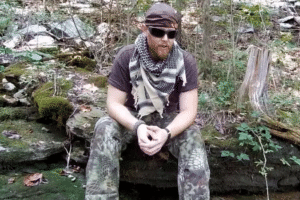
It is ideal for providing respiratory protection, as it involves the use of more material.
- Take one corner of the fabric and fold it on the opposite
- Folding the sides in half, form a triangle
- Place the folded edge in the middle of the forehead
- The right side of the keffiyeh should be half as long as the left side
- Place the left side under the chin
- With your left hand, take the right side to wrap your face
- Wrap the longer side around your head until the long end meets the shorter end
- Tie two overhand knots
- Adjust your shemagh and tie the knots tightly
This wrapping style allows you to reliably hide your face from the storm, dust, and rain. Even British soldiers wear a shemagh, which perfectly protects them from the sun, wind, and cold. However, using this method, you will not turn the keffiyeh into a scarf.
3) Neck scarf as a clothing accessory

Here is a step-by-step algorithm for how to tie a shemagh to keep up with fashion:
- Take one corner of your shemagh and put it on the opposite side
- Make a triangle by folding the corners
- Next, wrap the folded edge over your mouth and nose
- Cover the lower half of your face with one corner of the triangle
- Make sure that the other two corners cover the left and right sides of your face
- Take the left side of the scarf with the right hand, tie the ends of the two sides tightly
- Bring the two ends in front of your chest
- Bring down the folded edge of your shemagh
By making the last step, you will get a stylish and unusual image. Moreover, this scarf will diversify your standard-issue garment and set you apart from the crowd. Therefore, do not be afraid to experiment and wear such scarves.
4) How to tie a shemagh as a cowboy scarf
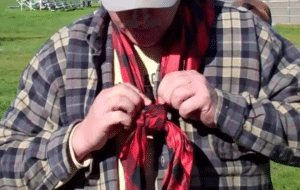
To make a neck cowboy scarf, take the corners of the shemagh and make a triangle. When you fold the scarf in this way, one corner of the shemagh covers the lower half of your face. You don’t need to hide the top part of your face. At the same time, the other two corners cover the left and right sides of the face. Without making a knot and covering your shoulders, cross the corners. Next, bring the ends in front of your chest and cross them over your shoulders, tying a knot. Remember that in this case, the knot should not be tight! It is a keffiyeh for the cowboy style, so it should be comfortable.
5) How to tie a shemagh as a bandana
I am sure that everyone at least once tried to tie a shemagh on the head like a bandana. Even now, many teenagers and adults wear a bandana in the summer as a headdress. Open Google, and you will see that one of the most frequent questions is the question “How to tie a shemagh like a bandana?”
Fold the fabric in half, make a triangle, and connect the ends. The two ends must be the same length. Place the shemagh on your forehead so that the shorter end is behind the back of the head. Connect the equal sides and tie the corner at the back. Adjust the bandana to make it comfortable for you. If you follow all these steps, you will tie the shemagh like a bandana!
Thus, you may wear the keffiyeh at any time of the year and tie it in any way. There are other ways of the binding shemagh, which will not be superfluous in survival. In any case, follow the instructions to quickly and easily tie the shemagh.
Final Words
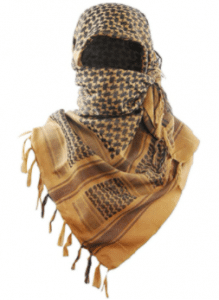
Frequently Asked Questions (FAQ)
Why do soldiers wear shemagh?
Indeed, soldiers on duty wear a shemagh. They use it to protect their face and head from the sun, sandstorms, and strong gusts of wind. As a rule, the shemagh is light, so it is not difficult for soldiers to wear it daily. In some cases, the shemagh is excellent as a camouflage, which is also vital for soldiers in the service.
How do you put a shemagh around your neck?
To put the shemagh on your neck, fold the ends and make a triangle out of the fabric. Put the shemagh on your chest and pull the ends back. Finally, you need to bring the extreme corners forward under the short part of the shemagh and tie a knot. It is a simplified way of wearing the product around the neck.
What color shemagh should I get?
You may choose any color of shemagh in the store. It all depends on your preferences and needs. For instance, if you want to abscond in an area, choose a shade of shemagh similar to this area. On the other hand, if you want to buy keffiyeh as a clothing accessory, choose a shade to match your style. In this case, the shemagh should be combined with the clothes and complement it.
Why do special forces wear shemaghs?
The military often uses this item like a blanket or pillow when they spend the night in tents and the wild. Second point: it covers their head so as not to get sun or heat stroke. Finally, the soldiers use the keffiyeh as a bag for carrying equipment and as a rope.


